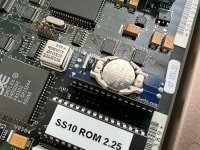glitch
Veteran Member
Picture says most of it:

I had a customer send in some M48T08 and M48T59 NVRAMs from some of their Sun systems recently. They'd purchased "new" NVRAMs from someone claiming to support Sun systems on eBay who'd sold a pile of them for $70-some USD. My customer wanted them rebuilt with one of our maintainable repair boards so they never had to deal with it again. Pictured above is what I found.It appears the seller digs out the old battery from the top with a Dremel or similar rotary tool, then pulls the tabs off, removing just the battery and leaving the tabs attached to the old NVRAM. They then put in a different battery and spot weld the old tabs to it. After this, the hole from the battery excavation is packed with some sort of filler putty, sanded flat, and blacktopped. They put a printed label over the top with the part number, rebuild date, etc.Note the deep digs in the top of the NVRAM IC. The epoxy on all four modules was also gummy, suggesting the NVRAMs were heated to make digging easier.
This is a closeup of the replacement battery:

Notice I'm not saying *new* battery...there are clearly two old spot weld marks, visible around the + mark on the above battery. So, either the seller is reusing old batteries (might explain why this one is already dead), or they're ordering batteries with tabs and ripping the tabs off. Either way, not how it ought to be done.
Hot garbage in my opinion, especially for the money. Save and rebuild your originals!

I had a customer send in some M48T08 and M48T59 NVRAMs from some of their Sun systems recently. They'd purchased "new" NVRAMs from someone claiming to support Sun systems on eBay who'd sold a pile of them for $70-some USD. My customer wanted them rebuilt with one of our maintainable repair boards so they never had to deal with it again. Pictured above is what I found.It appears the seller digs out the old battery from the top with a Dremel or similar rotary tool, then pulls the tabs off, removing just the battery and leaving the tabs attached to the old NVRAM. They then put in a different battery and spot weld the old tabs to it. After this, the hole from the battery excavation is packed with some sort of filler putty, sanded flat, and blacktopped. They put a printed label over the top with the part number, rebuild date, etc.Note the deep digs in the top of the NVRAM IC. The epoxy on all four modules was also gummy, suggesting the NVRAMs were heated to make digging easier.
This is a closeup of the replacement battery:

Notice I'm not saying *new* battery...there are clearly two old spot weld marks, visible around the + mark on the above battery. So, either the seller is reusing old batteries (might explain why this one is already dead), or they're ordering batteries with tabs and ripping the tabs off. Either way, not how it ought to be done.
Hot garbage in my opinion, especially for the money. Save and rebuild your originals!





